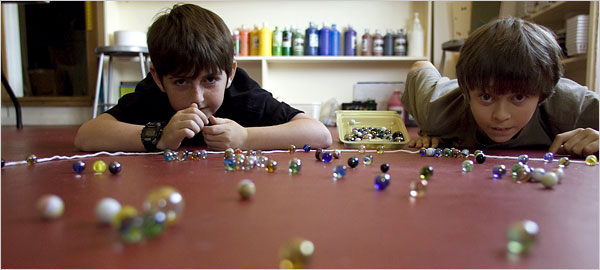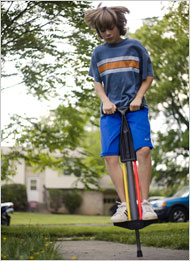

Putting The Skinned Knees Back Into
Playtime
The New York Times
Alex Williams
May 20, 2007

Randi Lynn Beach for
The New York Times
Joseph Gallo, left,
and his friend Keith forgo video games to play marbles. Joseph learned the game
at a seminar.
JOSEPH GALLO, 10, of
Santa Cruz, Calif., is well armed in the battle against childhood boredom, with
a bedroom arsenal that includes a computer hooked to the Internet, a DVD player,
two Game Boys, as well as an Xbox and a GameCube.

Michael Temchine for
The New York Times
Oliver Meade has
been encouraged to play outside, where he rules on the pogo stick.
But in recent weeks,
the hum of that war room of machinery has quieted because Joseph has acquired a
new playtime obsession that would have seemed quaint even in his parents’ day:
marbles.
He can thank
Well, not exactly.
Back then, children didn’t need to take seminars to learn to play a no-tech,
simple game. In the era of micromanaged play dates, overstuffed after-school
schedules, cuts to recess and parents terrified of injuries, lawsuits and
predators, many traditional childhood games have become lost arts, as antique as
the concept of idle time itself.
But lately, a number
of educators like Mr. Cohill, as well as parents and child-development
specialists are trying to spur a revival of traditional outdoor pastimes,
including marbles, hopscotch, red rover and kickball. They are attending play
conferences, teaching courses on how to play, and starting leagues for the kinds
of activities that didn’t used to need leagues — just, say, a stick and a ball.
They are spurred by concerns that a decline in traditional play robs the
imagination and inhibits social interaction, by personal nostalgia, and by a
desire to create a new bridge to connect generations — a bridge across both
sides of the Nintendo gap.
Although their
efforts have mostly yielded modest results, a hint that they may be on to
something comes with the success of an unlikely best seller, “The Dangerous Book
for Boys” (Collins), a sepia-toned celebration of the lost arts of childhood,
complete with information on how to make a tree house, fold paper airplanes and
skip stones. Within days of its publication earlier this month, the book had
soared to No. 2 on Amazon’s sales ranking, right behind the latest Harry Potter
installment. The book, by
Conn Iggulden said
in an e-mail message that he routinely received correspondence from parents who
yearn for a “return to simple pleasures,” which seems to stem from “potent
forces, like the realization that keeping your kids locked up in the house on
PlayStations isn’t actually that good for them; or the appalled reaction of many
parents to a health-and-safety culture that prevents half the activities they
took for granted as kids — and that they know were important to their growth and
confidence.”
Nevertheless, such
simple pleasures have not always been conspicuous in the lives of children over
the last two decades. “These kind of games, including tag, have practically died
out,” said Joan Almon, who is coordinator for the
Ms. Almon bemoaned
the fact that she often drives through leafy suburban streets on a sunny
afternoon and sees no children playing, adding, “We should be paying more
attention to these classical children’s games, which are almost lost now.”
Joseph, in fact,
compared the experience of indulging in this centuries-old activity to “being
inside a video game.”
Jill Gallo, Joseph’s
mother, is thrilled to see her son turn away from violent video games and she
thinks other parents should actively work to spread the outdated pastime among
children. “It won’t come back naturally,” said Ms. Gallo, 40. “We have to
introduce it. We have to support it.”
Rhonda Clements, a
professor of education at Manhattanville College in Purchase, N.Y., and a former
president of the American Association for the Child’s Right to Play, said that
this was already happening.
There’s a movement,”
she said of the effort to revive these games. Her department has been sponsoring
marble tournaments at local schools and trying to encourage faculty members to
teach games like
For many parents and
educators, the burgeoning interest in old-fashioned games is an outgrowth of a
broader campaign, spearheaded by a growing number of national and local advocacy
and research organizations, like the Alliance for Childhood, or the National
Institute for Play in Carmel Valley, Calif., to restore unstructured play in
children’s lives. They cite numerous studies that claim such play has many
benefits, from helping children develop their imaginations to helping them learn
to get along with others.
One group,
Birgit Meade, an
economist for the federal government who lives in College Park, doesn’t allow
her children — Oliver, 10, and Anna, 7 — to own a computer, and limits their DVD
watching, she said. Instead, she encourages them to collect caterpillars or play
jump rope in the front yard with friends.
Ms. Meade admits
that her son runs the risk of looking like “kind of an oddball” to his friends
for bouncing on a pogo stick while his friends blast away their afternoons
playing video games.
Still, Oliver noted
that he recently tallied 2,000 bounces in a single session. “There’s a lot more
things to do outdoors,” he said.
Perhaps the adults’
serious approach to playtime is paying off.
Kathy J. Spangler,
the director of national partnerships for the National Recreation and Park
Association in Ashburn, Va., which represent some 6,000 local parks departments,
said she had witnessed an increase in children playing traditional games like
four square, scavenger hunts and hopscotch at parks throughout the country in
the last few years.
Larry Betz, of
Benton, Ark., founder of the Little Rock Kickball Association, said that his
adult league was an instant hit when it started in 2004. Meanwhile, most of
their children found this old playground staple as foreign as a mortgage
application. “The irony of adults playing a kids’ game was lost on them,” Mr.
Betz said.
But after spending a
few seasons on the sideline, watching their parents have fun, many children are
suddenly showing interest in the game, Mr. Betz said. This year, he expects at
least 150 children to turn out for a new youth division.
CORY ABATE-SHEN, 41,
of Warren, N.J., cited a tinge of nostalgia as one reason she tried to teach the
playmates of her twin 6-year-olds, David and Philip, to leap through hopscotch
courts, shimmy in hula hoops, and chase each other around the lawn in games of
tag. Most kids, she said, need her direction, but once taught, “they can
immediately adapt and get into it.”
“You’re going to see
a real revolution,” she predicted, sounding a bit like a Thomas Paine of retro
play.
Nevertheless, some
critics believe that children best fire their imaginations and hone social
skills when left alone to make their own fun.
Dr. Geoffrey Godbey,
a professor of recreation at Penn State University, said the idea that parents
can revive old-fashioned play is contrary to the spirit of play. He blamed
“boomers who want to do it themselves again because they never grew up.”
His advice? “Let the
kids go.”
But Sara Boettrich
doesn’t want to. The
But when she tried
to pass it along to her daughter
Ms. Boettrich
admitted that she hadn’t seen the kids playing seven up, pickup sticks and
jacks, and that she had since abandoned her attempts to spark a love of them in
her daughter. She added, “I think I had more fun than she did.”